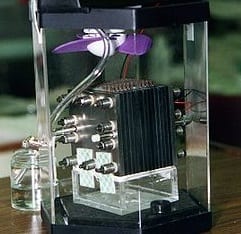When the fuel cell industry takes off it will be a multibillion dollar industry, generating thousands of jobs and significant wealth. Thanks to an ambitious state-of-the-art scientific programme, South Africa is ready for its slice of this pie, says Dr Olaf Conrad, Director of the HySA/Catalysis Competence Centre at the University of Cape Town Faculty of Engineering and the Built Environment.
A smart new building at the top of the University of Cape Town’s upper campus is the backdrop for one of South Africa’s most exciting energy research projects. Here the HySA (Hydrogen South Africa) Catalysis Centre, part of the SA government’s flagship programme in hydrogen and fuel cell technologies, has developed a product that has the potential to take the country into the future – a world driven largely by renewable energy sources like fuel cell technology. “When the fuel cell technology industry takes off, it is going to be a multibillion dollar market. Currently we are in the gold rush phase where everyone with a pick axe thinks they will find gold,” says Dr Olaf Conrad, Director of the HySA Catalysis Centre of Competence, co-hosted by the University of Cape Town Faculty of Engineering and the Built Environment and Mintek, the national R&D organisation for mineral processing. HySA has the ambitious objective of capturing 25% of the global fuel cell and hydrogen catalyst market by 2020. While many countries and academic programmes have their eye on capitalising on this market, they do not have the advantage that South Africa has: a vital component of fuel cell technology is platinum and South Africa controls an estimated 80% share of global platinum group metal (PGM) reserves. “As a technologist I am really excited about this technology,” says Dr Conrad. “It is because of its beauty – and its simplicity is its beauty. You take a fuel that has a huge amount of energy and convert it directly into electricity. You save a lot of steps and prevent many losses.” Fuel cells provide environmentally clean and extremely reliable power that can be used in many ways. For example, they are currently being implemented in the automotive industry by Toyota and Hyundai to produce commercial vehicles, although the cost for these models is still quite high. Other current applications that are being looked at include providing power and back-up power for the telecoms industry, for cellphone operators, for instance. The market for fuel cell technology is small at the moment because there is not a lot of demand for it, explains Dr Conrad. Creating demand for the technology is driven by awareness and knowledge sharing of this potentially ground-breaking renewable energy technology. Globally, countries are already preparing their industries for fuel cell technology change-overs, creating markets and encouraging demand and South Africa could become a significant supplier to these industries. “South Africa needs to get into the market at the same time as the US, European Union, Korea, Japan, etc and that is what we want to tap into. When those markets develop, they will shop around internationally for the best price and we need to be competitive at this stage otherwise they will look elsewhere,” says Dr Conrad.That is why the SA government launched a 15-year plan in 2008 to research, establish and commercially develop fuel cell technology for South Africa. “In a nutshell, rather than replicating academic research demonstrators for the umpteenth time, we focus on meeting immediate catalyst needs in the global fuel cell industry, and to support South African companies in their bid to penetrate the global fuel cell component and manufacturing market with their own products and services,” the Centre’s Sharon Blair said in the November 2013 issue of the Fuel Cells Bulletin. She leads Key Programme 2 on Portable Power, tasked with providing the Centre with a commercial focus to give direction to the technical programme.
At the end of the first five years, the Centre has not only met its goal of catching up to international standards in terms of understanding and establishing the technology academically – but it has also developed a fuel cell product, the Pt/C catalyst HySA-V40, that is available pre-commercially. This product has various applications and is currently being marketed as a reliable and cost-effective catalyst for various industries. “We have the product, now we need to get it into the hands of actual customers, to engage with foreign technology companies and provide them with support while they in return get a foothold in South Africa. So it is a mutually beneficial relationship that will see our catalyst becoming a major part in their future product,” says Dr Conrad. “It all boils down to the bottom line, which is what convinces technology companies to look to fuel cells as their future technology.” Although setting up a fuel cell system may be expensive initially, maintenance of the system is basic and much cheaper than the maintenance of current systems and back-up plans that may run on diesel or less reliable wind or solar power. Fuel cells could be also used to provide electricity to areas not currently serviced by grid power, to power field hospitals and provide Internet to far-off locations. “So there is a lot working in favour of fuel cell technology,” summarises Dr Conrad. But having the product is not enough. Being able to innovate and improve on the product as the technology matures is vital as this will be an important issue to future partners. Working out scalable models of the technology is also important. So research is still an important part of the Centre’s strategy. There is also not a lot of research on the effects of using less platinum in fuel cell products to reduce costs but without losing too much reliability – and this aspect is being looked at quite closely by the HySa Centre as it could have a massive impact on future applications. It is estimated that fuel cell technology will take over especially the automotive industry in future. South Africa at present has a large traditional car manufacturing industry, with thousands of people working on assembling traditional car parts. When this industry becomes obsolete, the HySa Centre wants to see fuel cell technology established to such an extent in South Africa, that it is able to drive new job creation and wealth generation for a new generation. Dr Conrad says in conclusion, “South Africa has a huge portion of the population that has been disadvantaged due to apartheid. This government is with this programme, committing to using a mineral wealth that is in ground here as a lever to uplift, empower and raise living conditions of a large numbers of the population. This is another extremely exciting side to this project.”







